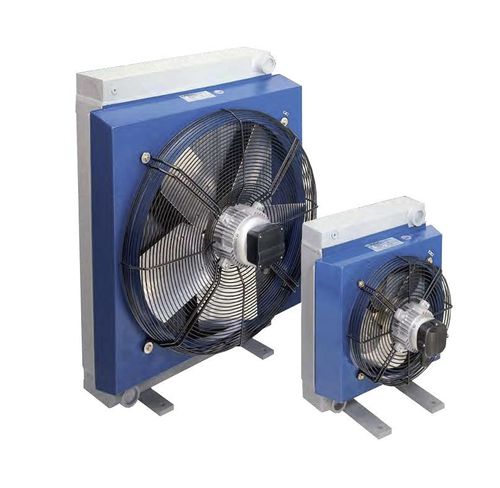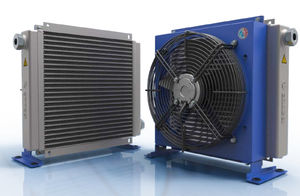
- Industrial machines and equipment
- Heat Exchanger and Refrigeration
- Liquid cooler
- Emmegi Heat Exchangers
Liquid cooler HPA COMPACTwith AC motor

Add to favorites
Compare this product
Characteristics
- Material
- liquid
- Other characteristics
- with AC motor
Description
EMMEGI air-oil heat exchangers are used for cooling
oil hydraulic systems using as the coolant ambient air
that passes over the radiant by means of a fan
operated by an electric or hydraulic motor.
The cooler element, in high resistance aluminium alloy,
is obtained by means of a braze-welding process
carried out under vacuum.
The particular configuration of the cooling pipes
increase the turbulence of the fluid consequently of the
exchange capacity; moreover, the presence of special
jets on the cooler finning further improves the total
transmission coefficient.
The result is a very small, light and robust
technologically advanced product.
Compatible fluids
. MINERAL OILS; HL; HLP.
. WATER-OIL EMULSION.
. WATER-GLYCOL.
. Consults EMMEGI for other fluids.
Technical specification of Cooler
Element
. Material: “long life” aluminium.
. Operating pressure: 20 bar
. Test pressure: 35 bar.
. Max operating temperature: 120°c.
. For specially “ aggressive” atmospheres contact
EMMEGI
Installation
The exchangers can be fitted in a horizontal position,
respecting the minimum distance from the wall (see
fig.1) so as to ensure a natural flow of cooling air.
The exchangers is usually installed on oil tank return
piping; it must also be protected from impacts and
mechanical vibrations by supports and must be
connected to the plant with flexible pipes.
Avoid subjecting the exchanger to sudden changes in
flow, hammering and pulsations that can cause
irreversible damage to the element.
We recommend installing a by-pass valve ( see fig.2 ) to
protect the exchanger from over-pressure generated
when the plants is started up due to high oil viscosity.
Catalogs
Other Emmegi Heat Exchangers products
Air-Oil Heat Exchangers
Related Searches
- Chiller
- Liquid chiller
- Heat exchanger unit
- Air chiller
- Liquid/liquid heat exchanger
- Industrial chiller
- Plate heat exchanger unit
- Compact chiller
- Tubular heat exchanger
- Gas/liquid heat exchanger unit
- Oil chiller
- Industrial heat exchanger
- Copper heat exchanger
- Small cooler
- Brazed plate heat exchanger
- Nickel heat exchanger
- Pressure heat exchanger
- High-pressure heat exchanger
- Small heat exchanger
- Water/oil heat exchanger
*Prices are pre-tax. They exclude delivery charges and customs duties and do not include additional charges for installation or activation options. Prices are indicative only and may vary by country, with changes to the cost of raw materials and exchange rates.






